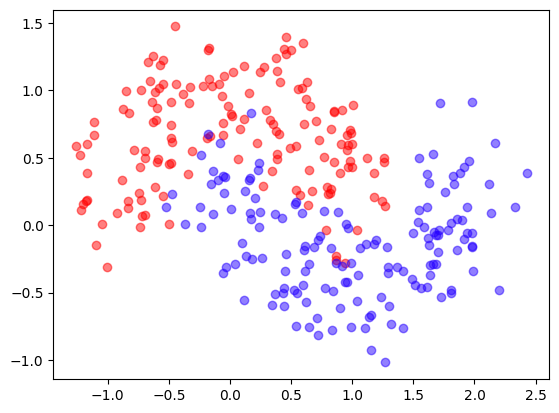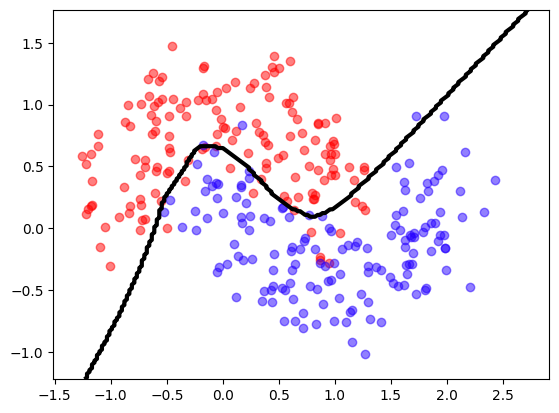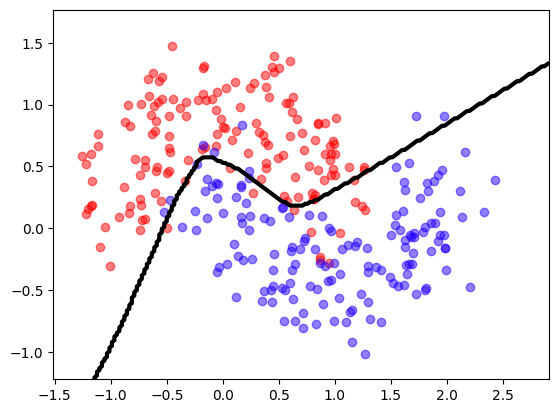4.3 - Dropout, pooling#
!wget -nc --no-cache -O init.py -q https://raw.githubusercontent.com/rramosp/2021.deeplearning/main/content/init.py
import init; init.init(force_download=False);
/content/init.py:2: SyntaxWarning: invalid escape sequence '\S'
course_id = '\S*deeplearning\S*'
replicating local resources
import numpy as np
import tensorflow as tf
import matplotlib.pyplot as plt
import pandas as pd
%matplotlib inline
%load_ext tensorboard
from sklearn.datasets import *
from local.lib import mlutils
tf.__version__
'2.19.0'
Dropout#
Dropout is a sort of regularization See
We use a synthetic dataset
from sklearn.datasets import make_moons
X, y = make_moons(300, shuffle=True, noise=0.25)
mlutils.plot_2Ddata(X,y)

def get_model(num_classes=2, nlayers=3, lsize=64, compile=True, dropout=None):
print("using",num_classes,"classes")
inputs = tf.keras.Input(shape=(2,), name="input_1")
layers = inputs
for _ in range(nlayers):
layers = tf.keras.layers.Dense(lsize, activation=tf.nn.relu)(layers)
if dropout is not None:
layers = tf.keras.layers.Dropout(dropout)(layers)
predictions = tf.keras.layers.Dense(num_classes, activation=tf.nn.softmax, name="output_1")(layers)
model = tf.keras.Model(inputs = inputs, outputs=predictions)
if compile:
model.compile(optimizer='adam',
loss='sparse_categorical_crossentropy',
metrics=['accuracy'])
return model
model = get_model()
model.summary()
using 2 classes
Model: "functional"
┏━━━━━━━━━━━━━━━━━━━━━━━━━━━━━━━━━┳━━━━━━━━━━━━━━━━━━━━━━━━┳━━━━━━━━━━━━━━━┓ ┃ Layer (type) ┃ Output Shape ┃ Param # ┃ ┡━━━━━━━━━━━━━━━━━━━━━━━━━━━━━━━━━╇━━━━━━━━━━━━━━━━━━━━━━━━╇━━━━━━━━━━━━━━━┩ │ input_1 (InputLayer) │ (None, 2) │ 0 │ ├─────────────────────────────────┼────────────────────────┼───────────────┤ │ dense (Dense) │ (None, 64) │ 192 │ ├─────────────────────────────────┼────────────────────────┼───────────────┤ │ dense_1 (Dense) │ (None, 64) │ 4,160 │ ├─────────────────────────────────┼────────────────────────┼───────────────┤ │ dense_2 (Dense) │ (None, 64) │ 4,160 │ ├─────────────────────────────────┼────────────────────────┼───────────────┤ │ output_1 (Dense) │ (None, 2) │ 130 │ └─────────────────────────────────┴────────────────────────┴───────────────┘
Total params: 8,642 (33.76 KB)
Trainable params: 8,642 (33.76 KB)
Non-trainable params: 0 (0.00 B)
model.fit(X, y, epochs=20, batch_size=8, verbose=False)
model.evaluate(X,y);
10/10 ━━━━━━━━━━━━━━━━━━━━ 0s 5ms/step - accuracy: 0.9073 - loss: 0.2015
predict = lambda X: model.predict(X).argmax(axis=1)
mlutils.plot_2Ddata_with_boundary(predict, X,y)
1250/1250 ━━━━━━━━━━━━━━━━━━━━ 4s 3ms/step
(np.float64(0.455775), np.float64(0.544225))

model = get_model(dropout=0.3)
model.summary()
using 2 classes
Model: "functional_1"
┏━━━━━━━━━━━━━━━━━━━━━━━━━━━━━━━━━┳━━━━━━━━━━━━━━━━━━━━━━━━┳━━━━━━━━━━━━━━━┓ ┃ Layer (type) ┃ Output Shape ┃ Param # ┃ ┡━━━━━━━━━━━━━━━━━━━━━━━━━━━━━━━━━╇━━━━━━━━━━━━━━━━━━━━━━━━╇━━━━━━━━━━━━━━━┩ │ input_1 (InputLayer) │ (None, 2) │ 0 │ ├─────────────────────────────────┼────────────────────────┼───────────────┤ │ dense_3 (Dense) │ (None, 64) │ 192 │ ├─────────────────────────────────┼────────────────────────┼───────────────┤ │ dropout (Dropout) │ (None, 64) │ 0 │ ├─────────────────────────────────┼────────────────────────┼───────────────┤ │ dense_4 (Dense) │ (None, 64) │ 4,160 │ ├─────────────────────────────────┼────────────────────────┼───────────────┤ │ dropout_1 (Dropout) │ (None, 64) │ 0 │ ├─────────────────────────────────┼────────────────────────┼───────────────┤ │ dense_5 (Dense) │ (None, 64) │ 4,160 │ ├─────────────────────────────────┼────────────────────────┼───────────────┤ │ dropout_2 (Dropout) │ (None, 64) │ 0 │ ├─────────────────────────────────┼────────────────────────┼───────────────┤ │ output_1 (Dense) │ (None, 2) │ 130 │ └─────────────────────────────────┴────────────────────────┴───────────────┘
Total params: 8,642 (33.76 KB)
Trainable params: 8,642 (33.76 KB)
Non-trainable params: 0 (0.00 B)
model.fit(X, y, epochs=20, batch_size=8, verbose=False)
model.evaluate(X,y);
10/10 ━━━━━━━━━━━━━━━━━━━━ 0s 6ms/step - accuracy: 0.9159 - loss: 0.2419
predict = lambda X: model.predict(X).argmax(axis=1)
mlutils.plot_2Ddata_with_boundary(predict, X,y)
1250/1250 ━━━━━━━━━━━━━━━━━━━━ 2s 2ms/step
(np.float64(0.4963), np.float64(0.5037))

model = get_model(nlayers=1, lsize=2, dropout=0.5)
model.summary()
using 2 classes
Model: "functional_2"
┏━━━━━━━━━━━━━━━━━━━━━━━━━━━━━━━━━┳━━━━━━━━━━━━━━━━━━━━━━━━┳━━━━━━━━━━━━━━━┓ ┃ Layer (type) ┃ Output Shape ┃ Param # ┃ ┡━━━━━━━━━━━━━━━━━━━━━━━━━━━━━━━━━╇━━━━━━━━━━━━━━━━━━━━━━━━╇━━━━━━━━━━━━━━━┩ │ input_1 (InputLayer) │ (None, 2) │ 0 │ ├─────────────────────────────────┼────────────────────────┼───────────────┤ │ dense_6 (Dense) │ (None, 2) │ 6 │ ├─────────────────────────────────┼────────────────────────┼───────────────┤ │ dropout_3 (Dropout) │ (None, 2) │ 0 │ ├─────────────────────────────────┼────────────────────────┼───────────────┤ │ output_1 (Dense) │ (None, 2) │ 6 │ └─────────────────────────────────┴────────────────────────┴───────────────┘
Total params: 12 (48.00 B)
Trainable params: 12 (48.00 B)
Non-trainable params: 0 (0.00 B)
model.fit(X, y, epochs=20, batch_size=8, verbose=False)
model.evaluate(X,y);
10/10 ━━━━━━━━━━━━━━━━━━━━ 0s 4ms/step - accuracy: 0.7754 - loss: 0.5600
model.layers
[<InputLayer name=input_1, built=True>,
<Dense name=dense_6, built=True>,
<Dropout name=dropout_3, built=True>,
<Dense name=output_1, built=True>]
observe the Dropout layer is used during training but has no weights
inp, l1, d, outp = model.layers
d.trainable, d.weights
(True, [])
but it is only used during training (default is training=False)
model(X[:2], training=False)
<tf.Tensor: shape=(2, 2), dtype=float32, numpy=
array([[0.66632426, 0.33367577],
[0.66282284, 0.3371772 ]], dtype=float32)>
model(X[:2], training=True) # each execution may be different
<tf.Tensor: shape=(2, 2), dtype=float32, numpy=
array([[0.8507542 , 0.14924584],
[0.41160962, 0.58839035]], dtype=float32)>
in inference a dropout layer is just a 1-to-1 mapping
tf.random.set_seed(0)
layer = tf.keras.layers.Dropout(.5, input_shape=(2,))
data = np.arange(1,11).reshape(5, 2).astype(np.float32)
print(data)
[[ 1. 2.]
[ 3. 4.]
[ 5. 6.]
[ 7. 8.]
[ 9. 10.]]
/usr/local/lib/python3.12/dist-packages/keras/src/layers/regularization/dropout.py:42: UserWarning: Do not pass an `input_shape`/`input_dim` argument to a layer. When using Sequential models, prefer using an `Input(shape)` object as the first layer in the model instead.
super().__init__(**kwargs)
outputs = layer(data, training=False).numpy()
print(outputs)
[[ 1. 2.]
[ 3. 4.]
[ 5. 6.]
[ 7. 8.]
[ 9. 10.]]
in training dropout randomly drops inputs and normalizes. See tf.keras.layers.Dropout
outputs = layer(data, training=True).numpy()
print(outputs)
[[ 0. 0.]
[ 0. 8.]
[ 0. 12.]
[14. 0.]
[ 0. 0.]]
data[outputs!=0].sum() / layer.rate, outputs[outputs!=0].sum()
(np.float32(34.0), np.float32(34.0))
Pooling#
!wget -nc https://s3.amazonaws.com/rlx/mini_cifar.h5
import h5py
with h5py.File('mini_cifar.h5','r') as h5f:
x_cifar = h5f["x"][:]
y_cifar = h5f["y"][:]
from sklearn.model_selection import train_test_split
x_train, x_test, y_train, y_test = train_test_split(x_cifar, y_cifar, test_size=.25)
print(x_train.shape, y_train.shape, x_test.shape, y_test.shape)
--2025-09-03 22:27:28-- https://s3.amazonaws.com/rlx/mini_cifar.h5
Resolving s3.amazonaws.com (s3.amazonaws.com)... 52.217.202.152, 52.217.101.142, 16.15.218.156, ...
Connecting to s3.amazonaws.com (s3.amazonaws.com)|52.217.202.152|:443... connected.
HTTP request sent, awaiting response... 200 OK
Length: 14803609 (14M) [binary/octet-stream]
Saving to: ‘mini_cifar.h5’
mini_cifar.h5 100%[===================>] 14.12M 60.3MB/s in 0.2s
2025-09-03 22:27:28 (60.3 MB/s) - ‘mini_cifar.h5’ saved [14803609/14803609]
(2253, 32, 32, 3) (2253,) (751, 32, 32, 3) (751,)
def get_conv_model(num_classes=3, img_size=32, use_maxpooling=True, compile=True):
print ("using",num_classes,"classes")
inputs = tf.keras.Input(shape=(img_size,img_size,3), name="input_1")
layers = tf.keras.layers.Conv2D(15,(5,5), activation="relu")(inputs)
if use_maxpooling:
layers = tf.keras.layers.MaxPool2D((2,2), name="pooling")(layers)
layers = tf.keras.layers.Conv2D(60,(5,5), activation="relu")(layers)
layers = tf.keras.layers.Flatten()(layers)
layers = tf.keras.layers.Dense(16, activation=tf.nn.relu)(layers)
layers = tf.keras.layers.Dropout(0.2)(layers)
predictions = tf.keras.layers.Dense(num_classes, activation=tf.nn.softmax, name="output_1")(layers)
model = tf.keras.Model(inputs = inputs, outputs=predictions)
if compile:
model.compile(optimizer='adam',
loss='sparse_categorical_crossentropy',
metrics=['accuracy'])
return model
observe the size of the models with and without pooling
model = get_conv_model(use_maxpooling=False)
model.summary()
using 3 classes
Model: "functional_3"
┏━━━━━━━━━━━━━━━━━━━━━━━━━━━━━━━━━┳━━━━━━━━━━━━━━━━━━━━━━━━┳━━━━━━━━━━━━━━━┓ ┃ Layer (type) ┃ Output Shape ┃ Param # ┃ ┡━━━━━━━━━━━━━━━━━━━━━━━━━━━━━━━━━╇━━━━━━━━━━━━━━━━━━━━━━━━╇━━━━━━━━━━━━━━━┩ │ input_1 (InputLayer) │ (None, 32, 32, 3) │ 0 │ ├─────────────────────────────────┼────────────────────────┼───────────────┤ │ conv2d (Conv2D) │ (None, 28, 28, 15) │ 1,140 │ ├─────────────────────────────────┼────────────────────────┼───────────────┤ │ conv2d_1 (Conv2D) │ (None, 24, 24, 60) │ 22,560 │ ├─────────────────────────────────┼────────────────────────┼───────────────┤ │ flatten (Flatten) │ (None, 34560) │ 0 │ ├─────────────────────────────────┼────────────────────────┼───────────────┤ │ dense_7 (Dense) │ (None, 16) │ 552,976 │ ├─────────────────────────────────┼────────────────────────┼───────────────┤ │ dropout_5 (Dropout) │ (None, 16) │ 0 │ ├─────────────────────────────────┼────────────────────────┼───────────────┤ │ output_1 (Dense) │ (None, 3) │ 51 │ └─────────────────────────────────┴────────────────────────┴───────────────┘
Total params: 576,727 (2.20 MB)
Trainable params: 576,727 (2.20 MB)
Non-trainable params: 0 (0.00 B)
model = get_conv_model(use_maxpooling=True)
model.summary()
using 3 classes
Model: "functional_4"
┏━━━━━━━━━━━━━━━━━━━━━━━━━━━━━━━━━┳━━━━━━━━━━━━━━━━━━━━━━━━┳━━━━━━━━━━━━━━━┓ ┃ Layer (type) ┃ Output Shape ┃ Param # ┃ ┡━━━━━━━━━━━━━━━━━━━━━━━━━━━━━━━━━╇━━━━━━━━━━━━━━━━━━━━━━━━╇━━━━━━━━━━━━━━━┩ │ input_1 (InputLayer) │ (None, 32, 32, 3) │ 0 │ ├─────────────────────────────────┼────────────────────────┼───────────────┤ │ conv2d_2 (Conv2D) │ (None, 28, 28, 15) │ 1,140 │ ├─────────────────────────────────┼────────────────────────┼───────────────┤ │ pooling (MaxPooling2D) │ (None, 14, 14, 15) │ 0 │ ├─────────────────────────────────┼────────────────────────┼───────────────┤ │ conv2d_3 (Conv2D) │ (None, 10, 10, 60) │ 22,560 │ ├─────────────────────────────────┼────────────────────────┼───────────────┤ │ flatten_1 (Flatten) │ (None, 6000) │ 0 │ ├─────────────────────────────────┼────────────────────────┼───────────────┤ │ dense_8 (Dense) │ (None, 16) │ 96,016 │ ├─────────────────────────────────┼────────────────────────┼───────────────┤ │ dropout_6 (Dropout) │ (None, 16) │ 0 │ ├─────────────────────────────────┼────────────────────────┼───────────────┤ │ output_1 (Dense) │ (None, 3) │ 51 │ └─────────────────────────────────┴────────────────────────┴───────────────┘
Total params: 119,767 (467.84 KB)
Trainable params: 119,767 (467.84 KB)
Non-trainable params: 0 (0.00 B)
observe the layer has no weights
p = model.get_layer('pooling')
p.trainable, p.weights
(True, [])
the layer can be applied anywhere there is a 2D structure
x_cifar[:1].shape, p(x_cifar[:1]).shape
((1, 32, 32, 3), TensorShape([1, 16, 16, 3]))
observe how the max is computed over each pixel and over each channel
# a random position
i,j = np.random.randint(16, size=2)*2
x_cifar[:1][0,i:i+2,j:j+2]
array([[[0.76078431, 0.72941176, 0.72156863],
[0.85882353, 0.82745098, 0.81960784]],
[[0.68627451, 0.65490196, 0.64705882],
[0.78823529, 0.75294118, 0.74509804]]])
p(x_cifar[:1])[0,i//2,j//2,:]
<tf.Tensor: shape=(3,), dtype=float32, numpy=array([0.85882354, 0.827451 , 0.81960785], dtype=float32)>

